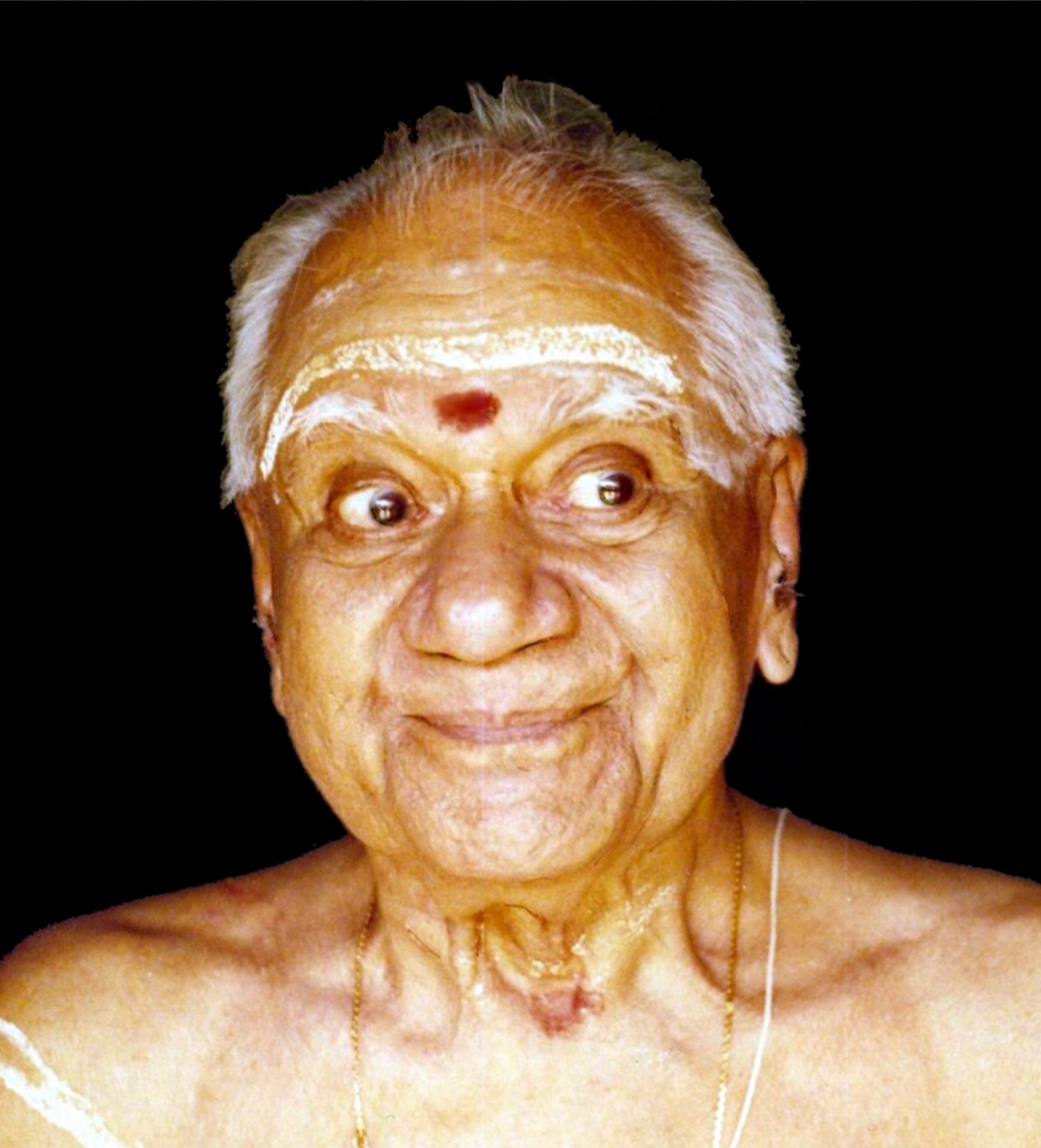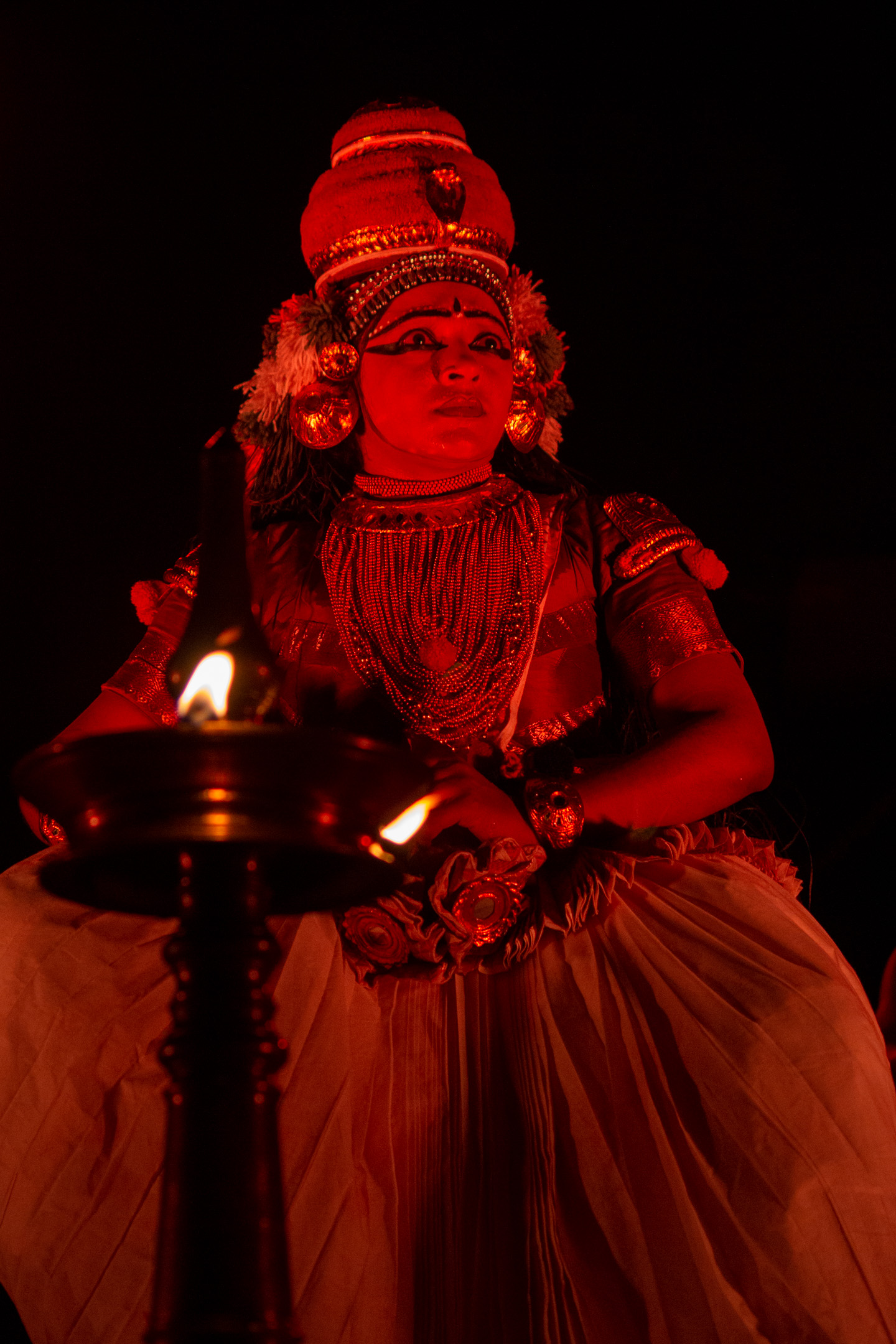|
Ramanchakyar
Late Shri Guru Painkulam Raman Chakyar was a Chakyar Koothu and Koodiyattam performer. He won the Kerala Sahitya Academy Award in 1980. He was also a teacher of Vachika Abhinaya in both Chakyar Koothu and Koodiyattam. Life Starting in 1925, he performed regular programmes in various temples and religious places spread all over Kerala. He is credited with first bringing this artform outside the temples and closer to general audiences. He directed, supervised, and participated in more than 100 Koodiyattam plays, which he edited and condensed for contemporary audiences while striving to maintain artistic integrity and authenticity. He had more than 1000 stage appearances in different roles, besides being a regular participant in All India Radio programmes. He produced and staged the 2nd Act of Sakunthalam, 3rd Act of Nagananda and Jadayuvadhanam in Ascharyachoodamani. He also supervised and participated in the production of a colour documentary film on koodiyattam in 1974. ... [...More Info...] [...Related Items...] OR: [Wikipedia] [Google] [Baidu] |
Painkulam
Painkulam (Malayalam: പൈങ്കുളം) is a village in Panjal Grama Panchayat in Thrissur district in the state of Kerala, India. The village, situated on the shores of Bharathappuzha, is the birthplace of Late Raman Chakyar, who was a leader with a vision and a mission to the world of art. He taught the temple arts Koodiyattam and Chakyar Koothu to non Chakyar castes and democratized the art form. Painkulam village has a government upper primary school, several preschool nurseries and a local library (Grameena Vayanasala). An aqueduct, built in 1960s by the irrigation department, is a major attraction in the village. Vazhalikkavu Temple is situated in Painkulam, this evergreen location (One side forest area, one side Bharathapuzha, and vayal) provide a good situation to pilgrims. The festival is basically the birthday of Devi and this is the event which is celebrated by all the localities irrespective of caste and race. When the elephants are decorated with 'Caparis ... [...More Info...] [...Related Items...] OR: [Wikipedia] [Google] [Baidu] |
Kerala
Kerala ( ; ) is a state on the Malabar Coast of India. It was formed on 1 November 1956, following the passage of the States Reorganisation Act, by combining Malayalam-speaking regions of the erstwhile regions of Cochin, Malabar, South Canara, and Thiruvithamkoor. Spread over , Kerala is the 21st largest Indian state by area. It is bordered by Karnataka to the north and northeast, Tamil Nadu to the east and south, and the Lakshadweep Sea to the west. With 33 million inhabitants as per the 2011 census, Kerala is the 13th-largest Indian state by population. It is divided into 14 districts with the capital being Thiruvananthapuram. Malayalam is the most widely spoken language and is also the official language of the state. The Chera dynasty was the first prominent kingdom based in Kerala. The Ay kingdom in the deep south and the Ezhimala kingdom in the north formed the other kingdoms in the early years of the Common Era (CE). The region had been a prominent spic ... [...More Info...] [...Related Items...] OR: [Wikipedia] [Google] [Baidu] |
Chakyar Koothu
Chakyar Koothu (pronounced ) is a performance art from Kerala, India. It is primarily a type of highly refined monologue where the performer narrates episodes from Hindu epics (such as the ''Ramayana'' and the ''Mahabharata'') and stories from the Puranas. Sometimes, however, it is also a traditional equivalent of the modern stand-up comedy act, incorporating commentary on current socio-political events (and personal comments directed at the members of the audience). The performance "Koothu" means dance ... which is a misnomer, as facial expressions are emphasized and there is minimal choreography. It is performed in the Koothambalam; a place inside Hindu temples specifically designed for performing Kutiyattam and Chakyar Koothu. Ideally, the performance takes place in conjunction with festivals, presented by members of the Chakyar community along with the Ambalavasi Nambiars. It is a solo performance, by a narrator in a distinctive headgear and black moustache with his torso ... [...More Info...] [...Related Items...] OR: [Wikipedia] [Google] [Baidu] |
Koodiyattam
Koodiyattam ( ml, കൂടിയാട്ടം; IAST: kūṭiyāṭṭaṁ; ) is a traditional performing art form in the state of Kerala, India. It is a combination of ancient Sanskrit theatre with elements of ''Koothu'', an ancient performing art from the Sangam era. It is officially recognised by UNESCO as a Masterpiece of the Oral and Intangible Heritage of Humanity. Origin Koodiyattam, meaning "combined acting" in Malayalam, combines Sanskrit theatre performance with elements of traditional koothu. It is traditionally performed in temple theatres known as ''koothambalams''. It is the only surviving art form that uses drama from ancient Sanskrit theatre. It has a documented history of a thousand years in Kerala, but its origins are not known. Koodiyattam and Chakyar koothu were among the dramatized dance worship services in the temples of ancient India, particularly Kerala. Both koodiyattam and Chakyar koothu originated from the ancient art form koothu, which is menti ... [...More Info...] [...Related Items...] OR: [Wikipedia] [Google] [Baidu] |
Abhinaya
Abhinaya ( Sanskrit ''abhi-'' 'towards' + ''nii-'' 'leading/guide') is the art of expression in Indian aesthetics. More accurately it means "leading an audience towards" the experience (') of a sentiment ('). The concept, derived from Bharata Muni's '' Natya Shastra'', is used as an integral part of all Indian classical dance styles. ''Abhinaya'' can be divided into four, according to the '' Natya Shastra''. pp. 131–186 Expression of the limbs (''Āṅgika Abhinaya'') Angika Abhinaya denotes the movements of angas like head, hands, waist and face. Pratyangas like shoulder, shoulder arm's, thighs, knees and elbows and upangas like eyes, eyelid, cheeks, nose, lips and teeth. Additional hastas (hand gestures) have always played a significant role in conveyance of the emotion and through of a soul. Many of the natural gestures are found common to mankind and their meaning easily understood. Expression of speech (''Vāchika Abhinaya'') Speech is used in drama and also in music wh ... [...More Info...] [...Related Items...] OR: [Wikipedia] [Google] [Baidu] |
Authenticity In Art
Authenticity in art is manifest in the different ways that a work of art, or an artistic performance, can be considered authentic. The initial distinction is between ''nominal authenticity'' and ''expressive authenticity''. In the first sense, nominal authenticity is the correct identification of the author of a work of art; of how closely an actor or an actress interprets a role in a stageplay as written by the playwright; of how well a musician's performance of an artistic composition corresponds to the composer's intention; and how closely an '' objet d’art'' conforms to the artistic traditions of its genre. In the second sense, expressive authenticity is how much the work of art possesses inherent authority of and about its subject, and how much of the artist's intent is in the work of art. For the spectator, the listener, and the viewer, the ''authenticity of experience'' is an emotion impossible to recapture beyond the first encounter with the work of art in its original ... [...More Info...] [...Related Items...] OR: [Wikipedia] [Google] [Baidu] |
Bhagavadajjukam
The ''Bhagavadajjukam'' (Sanskrit; translated as ''The Ascetic and the Courtesan'' or ''The Hermit and the Harlot'') is a Sanskrit farce composed in the 7th century CE, usually attributed to Bodhayana. However, inscriptional and scholarly evidence indicate that the play was written by the Pallava king Mahendravarman I, who also wrote a prominent farce known as the Mattavilasa Prahasana. It is one of the two earliest surviving examples of a satirical play (or ''prahasana'', one of the ten types of plays described in the treatise '' Natya Shastra'') in Sanskrit literature. Featuring witty exchanges, an episode about the transmigration of souls and a discussion on Hindu dharma, the comical play was intended to mock the doctrines of Buddhism, whose rise at the time presented a challenge to the dominance of Hinduism in India. Characters *Parivrajakamonk or master *Shandilyadisciple *Vasantsenacourtesan *Ramilakacourtesan's lover *Vidushaka jester *A quack doctor *Yamaduta, messen ... [...More Info...] [...Related Items...] OR: [Wikipedia] [Google] [Baidu] |
Dancers From Kerala
Dance is a performing art form consisting of sequences of movement, either improvised or purposefully selected. This movement has aesthetic and often symbolic value. Dance can be categorized and described by its choreography, by its repertoire of movements, or by its historical period or place of origin. An important distinction is to be drawn between the contexts of theatrical and participatory dance, although these two categories are not always completely separate; both may have special functions, whether social, ceremonial, competitive, erotic, martial, or sacred/liturgical. Other forms of human movement are sometimes said to have a dance-like quality, including martial arts, gymnastics, cheerleading, figure skating, synchronized swimming, marching bands, and many other forms of athletics. There are many professional athletes like, professional football players and soccer players, who take dance classes to help with their skills. To be more specific professional athletes tak ... [...More Info...] [...Related Items...] OR: [Wikipedia] [Google] [Baidu] |
People From Thrissur District
A person ( : people) is a being that has certain capacities or attributes such as reason, morality, consciousness or self-consciousness, and being a part of a culturally established form of social relations such as kinship, ownership of property, or legal responsibility. The defining features of personhood and, consequently, what makes a person count as a person, differ widely among cultures and contexts. In addition to the question of personhood, of what makes a being count as a person to begin with, there are further questions about personal identity and self: both about what makes any particular person that particular person instead of another, and about what makes a person at one time the same person as they were or will be at another time despite any intervening changes. The plural form "people" is often used to refer to an entire nation or ethnic group (as in "a people"), and this was the original meaning of the word; it subsequently acquired its use as a plural form of p ... [...More Info...] [...Related Items...] OR: [Wikipedia] [Google] [Baidu] |
Indian Male Dancers
Indian or Indians may refer to: Peoples South Asia * Indian people, people of Indian nationality, or people who have an Indian ancestor ** Non-resident Indian, a citizen of India who has temporarily emigrated to another country * South Asian ethnic groups, referring to people of the Indian subcontinent, as well as the greater South Asia region prior to the 1947 partition of India * Anglo-Indians, people with mixed Indian and British ancestry, or people of British descent born or living in the Indian subcontinent * East Indians, a Christian community in India Europe * British Indians, British people of Indian origin The Americas * Indo-Canadians, Canadian people of Indian origin * Indian Americans, American people of Indian origin * Indigenous peoples of the Americas, the pre-Columbian inhabitants of the Americas and their descendants ** Plains Indians, the common name for the Native Americans who lived on the Great Plains of North America ** Native Americans in the Un ... [...More Info...] [...Related Items...] OR: [Wikipedia] [Google] [Baidu] |
Koodiyattam Exponents
Koodiyattam ( ml, കൂടിയാട്ടം; IAST: kūṭiyāṭṭaṁ; ) is a traditional performing art form in the state of Kerala, India. It is a combination of ancient Sanskrit theatre with elements of ''Koothu'', an ancient performing art from the Sangam era. It is officially recognised by UNESCO as a Masterpiece of the Oral and Intangible Heritage of Humanity. Origin Koodiyattam, meaning "combined acting" in Malayalam, combines Sanskrit theatre performance with elements of traditional koothu. It is traditionally performed in temple theatres known as ''koothambalams''. It is the only surviving art form that uses drama from ancient Sanskrit theatre. It has a documented history of a thousand years in Kerala, but its origins are not known. Koodiyattam and Chakyar koothu were among the dramatized dance worship services in the temples of ancient India, particularly Kerala. Both koodiyattam and Chakyar koothu originated from the ancient art form koothu, which is menti ... [...More Info...] [...Related Items...] OR: [Wikipedia] [Google] [Baidu] |




_1938.jpg)
